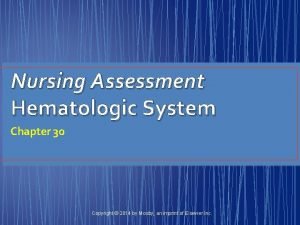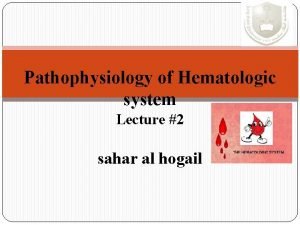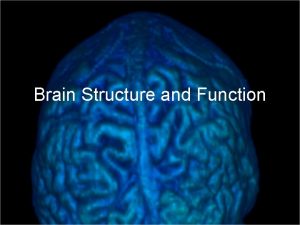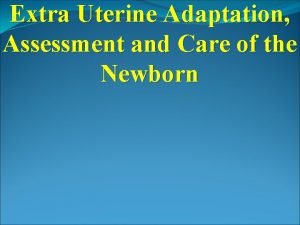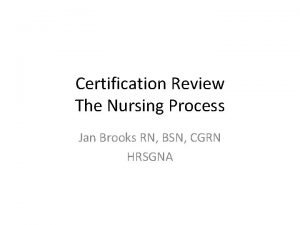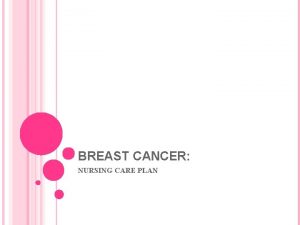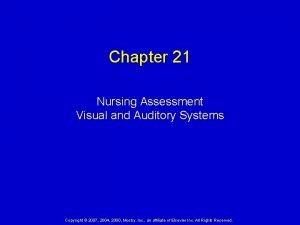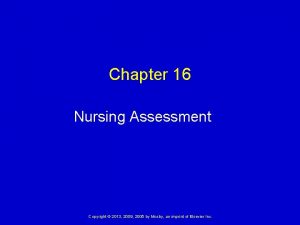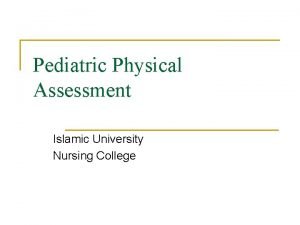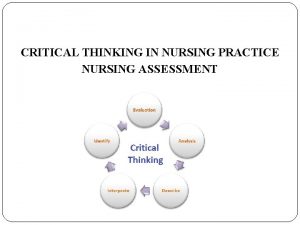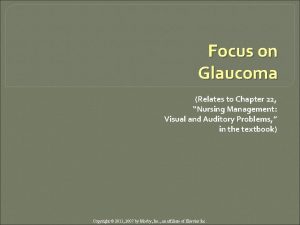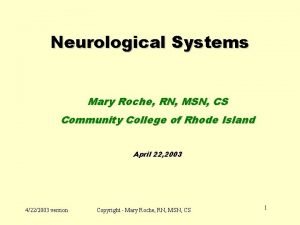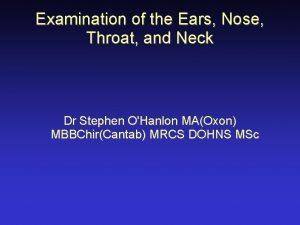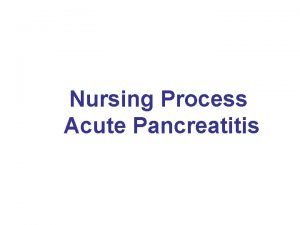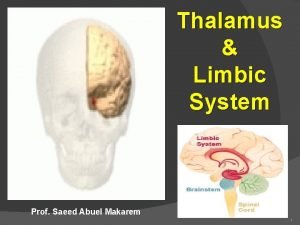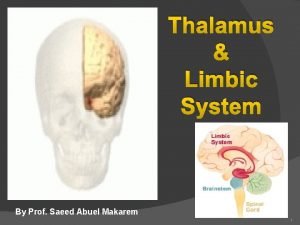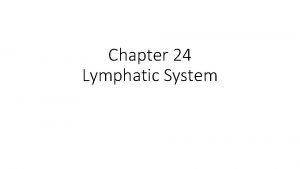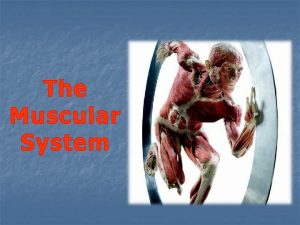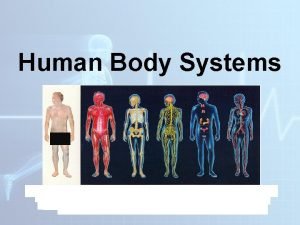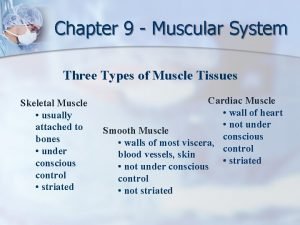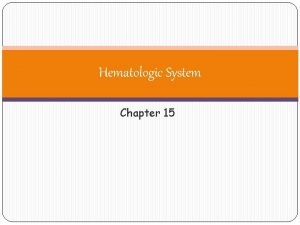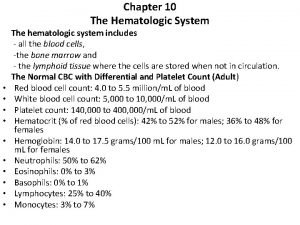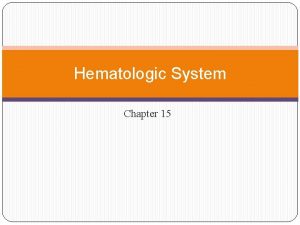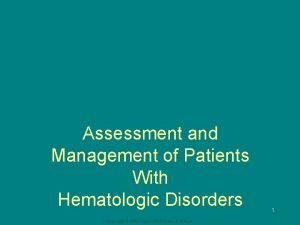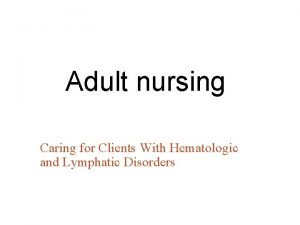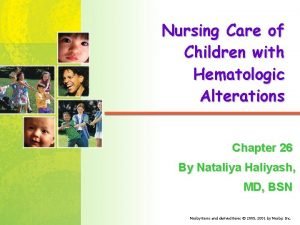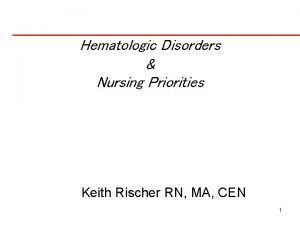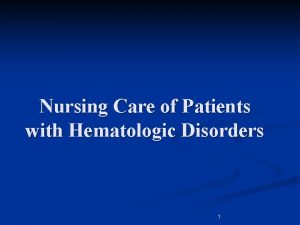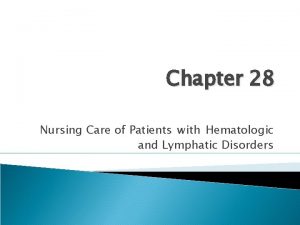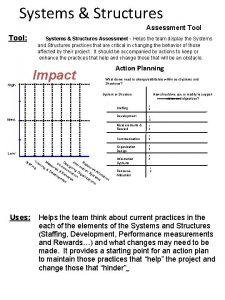Nursing Assessment Management Hematologic System 1 Structures and


















































- Slides: 50

Nursing Assessment & Management: Hematologic System 1

Structures and Functions of Hematologic System • Two major components of blood – Cells & Plasma • Bone Marrow – Hematopoiesis (Blood cell production) • RBCs (erythrocytes) – oxygen transportation • WBCs (leukocytes) – fight infection – Granulocytes: Neutrophils, Basophils, Eosinophils – Agranulocytes: Lymphocytes, Monocytes • Platelets – coagulation 2

Structures and Functions of Hematologic System 3

Structures and Functions of Hematologic System 4

Iron Metabolism 5

Normal Clotting Mechanisms • Coagulation – Platelets – Clotting factors – Fibrin – Other cells (RBCs & WBCs) 6

Spleen • Spleen – 4 major functions – Hemiapoetic • Fetal RBC production – Filitration • Removal RBCs • Recycle iron – Immunologic • Supplies lymphocytes, monocytes, & immunoglobulins – Storage • RBCs & Platelets 7

Lymph System & Liver • Lymph System – Returns proteins, fat & hormones to blood • Liver – Filters – Produces procoagulants – Stores iron 8

Gerontologic Considerations: Effects of Aging on Hematologic System • ↓Red marrow & stem cells • ↓Hemoglobin (especially in men) • ↓Nutritional intake of iron • Table 30 -4, p. 648: Differences in lab values 9

Assessment of Hematologic System • Subjective Data – Important health information • Past health history • Medications (Table 30 -5, p. 649) • Surgery or other treatments 10

Assessment of Hematologic System • Objective Data – Physical examination • • • Lymph node assessment Palpation of liver or spleen Eyes Mouth Skin assessment • Focused assessment, p. 654 11

Diagnostic Studies • Laboratory Studies – Complete blood count (Table 30 -8, p. 655) – Blood Typing and Rh Factor – Clotting studies (Table 30 -9, p. 656) – Iron metabolism 12

Diagnostic Studies • Radiologic Studies • Biopsies – Bone marrow • Nursing responsibility – Explain procedure – Obtain signed consent – Analgesic administration – Applying dressing – Assessing site for bleeding 13

Diagnostic Studies • Biopsies, continued – Lymph node biopsy (open/closed) • Nursing responsibility – Explaining procedure – Obtaining consent form – Applying pressure to site – Observe for bleeding – Monitor vital signs – Changing dressing per sterile technique – Observe wound for healing and infection. 14

Hematologic Health Problems Anemia Copyright © 2011, 2007 by Mosby, Inc. , an affiliate of Elsevier Inc. 15

Anemia • What causes anemia? – More than 400 types divided into 3 groups • Caused by blood loss • Caused by decreased or faulty RBC production • Caused by destruction of RBCs • Treatment based on cause 16

Sickle Cell Disease: Assessment • Signs & Symptoms – Pain – Dyspnea, tachycardia – Fatigue – Fever – Pallor and/or jaundice • Diagnostic Studies – CBC – Hemoglobin electrophoresis – Sickle cell test 17

SCD: Genetic Disposition

Nursing & Collaborative Management: Sickle Cell Disease • • Alleviating symptoms Minimizing end organ damage Treating serious complications Teaching – Avoid high altitudes – Maintain adequate fluid intake • Administer immunizations • CLASS ACTIVITY: CASE STUDY 19

Asessment: Polycythemia • S&S r/t hypervolemia and hyperviscosity – Headache, dizziness, tinnitus, vision problems – Hypertension, dyspnea, angina, fatigue – Pruritis, erythema of face, hands, and feet – Petechiae, ecchymoses, excessive bleeding – Symptoms of thrombophlebitis • Diagnostic tests – Bone marrow biopsy – CBC w/ differential – Erythropoietin level 20

Nursing & Collaborative Management: Polycythemia • GOAL: Reduce thickness of blood & prevent bleeding and clotting • Phlebotomy • Myelosuppresives (ex: Hydroxyurea) • Low-dose aspirin • Hydration • Evaluate I&O • Protect from injury 21

Thrombocytopenia • Any disorder causing abnormally low platelet count less than 150, 000/μL • Types – Immune thrombocytopenia purpura – Thrombotic thrombocytopenia purpura – Heparin-induced thrombocytopenia purpura • Diagnostic tests • CBC w/ platelet count less than 150, 000/μL • Bleeding time prolonged • Bone marrow aspiration 22

Assessment: Thrombocytopenia • Immune thrombocytopenia purpura – Autoimmune disorder – Signs & Symptoms • • Petechiae, purpura, and ecchymoses Nosebleeds Gingival bleeding Blood in urine or stool – Treatment • Corticosteroids • Drugs to ↑ platelets • Splenectomy 23

Assessment: Thrombocytopenia • Thrombotic thrombocytopenia purpura – Inherited or acquired – Signs & Symptoms • • Petechiae, purpura, and echhymoses Tachycardia, dyspnea, fatigue Headache, confusion Proteinuria, fever – Treatment • Plasmapheresis • Other treatments same as ITP 24

Assessment: Thrombocytopenia • Heparin-induced thrombocytopenia – Complication of heparin therapy – Signs & Symptoms • • • Weakness, flushing, headache Black, reddish, or bluish skin discoloration Chest pain, dyspnea, tachycardia, hypertension Fever, chills, diaphoresis N/V, coughing up blood Symptoms of phlebitis – Treatment • Plasmapheresis • Protamine sulfate & antithrombolytics 25

Nursing Management: Thrombocytopenia • Nursing Implementation – Health promotion – Teaching (Table 31 -16, p. 684) • Avoid aspirin • Protect against injury and infection – Acute intervention • • Monitor lab values, I&O Assess for signs of bleeding and/or phlebitis Soft toothbrush or toothette, frequent oral care Avoid injections if possible – Ambulatory and home care • Determine home need for assistance with ADLs 26

Hemophilia and Von Willebrand’s Disease 27

Hemophilia: Genetic Disposition 28

Hemophilia and Von Willebrand’s Disease • Signs & Symptoms – Excessive and prolonged bleeding • Internal and external hemorrhaging • Hemarthrosis can lead to joint deformity • Cranial bleed – serious complication • Diagnostic tests – Table 31 -18, p. 686 • Treatment – Replacement therapy – Gene therapy 29

Hemophilia and Von Willebrand’s Disease 30

Nursing Management: Hemophilia • Nursing Implementation – Health promotion • Protect against injury – Acute intervention • • • Control bleeding and administer factor as ordered Bedrest and ice pack if joint bleeding Analgesics as ordered (NO ASPIRIN) Mobilize and ROM exercises when bleeding controlled Monitor for complications and side effects of factor – Ambulatory and home care • Teach S&S and when to notify physician 31

Disseminated Intravascular Coagulation • Signs & Symptoms – Unexpected bleeding (may be multiple sites) – Blood clots – Weakness, malaise, and fever – Hypotension • Diagnostic tests – Table 31 -21, p. 688 32

Disseminated Intravascular Coagulation 33

Disseminated Intravascular Coagulation 34

Nursing and Collaborative Management: DIC • Collaborative Care – GOAL: Determine and treat cause – Stabilize patient: O 2 & volume replacement – FFP, platelets, and cryoprecipitate – Heparin therapy • Nursing Implementation – Assess for signs of external & internal bleeding – Assess for organ damage (ex: ↓ renal output) – Administer blood products and medications as ordered 35

Neutropenia • Signs & Symptoms – Fever and signs of infection • Sore throat, dysphagia, oral lesions • Diarrhea, rectal tenderness, vaginal itching/discharge • SOB, nonproductive cough • Diagnostic Studies – CBC w/ differential • Neutrophil count 500 – 1000 cells/μL (moderate risk) • Neutrophil count less than 500 cells/μL (high risk) – Bone marrow 36

Nursing and Collaborative Management: Neutropenia • • • HANDWASHING!!! Identify and treat cause (if possible) Assess for S&S of infection Antibiotic therapy Reverse isolation Frequent oral care Screen visitors No raw veggies/fruits No flowers 37

Leukemia • Signs & Symptoms (most common) – Fever and night sweats – Headaches – Bruising or bleeding easily – Bone or joint pain – Enlarged spleen and/or liver – Swollen lymph nodes – Frequent infections – Fatigue and weakness – Weight loss and anorexia 38

Leukemia • Diagnostic Studies – CBC w/ differential • ↑ WBCs / ↓ other blood cells – Bone marrow aspiration & biopsy – Cytology studies • Collaborative Care (Table 31 -26, p. 697) – Chemotherapy – Radiation therapy – Corticosteroids – Biologic therapy – Hematopoietic stem cell transplantation 39


Nursing Management: Leukemia • Nursing Assessment (Table 31 -27, p. 698) • Nursing Implementation – Psychosocial support measures – Manage side effects of chemo – Protect from infection – Provide frequent rest periods – Encourage nutritional intak – Provide frequent oral care – Assess for CNS changes – Encourage vaccinations 41

Lymphomas 42

Hodgkin’s Lymphoma • Signs & Symptoms – Onset insidious – 1 st sign: Painless swelling in neck, axilla, or groin – Abdominal pain r/t enlarged spleen or liver – Fever, chills, and night sweats – Unexplained weight loss and fatigue – Pruritis (25% of cases) • Diagnostic tests – CBC w/ differential, Sedimentation rate, Chemistry – Radiology – Bone marrow – Lymph node biopsy 43

Reed-Sternberg cells are large, abnormal lymphocytes that may contain more than one nucleus. These cells are found in Hodgkin’s lymphoma.

Hodgkin’s Lymphoma • Staging – A or B classification based on symptoms at time of diagnosis – IV indicates location and extent of disease 45

Nursing & Collaborative Management: Hodgkin’s Lymphoma • Chemotherapy – ABVD: doxorubicin (Adriamycin), bleomycin, vinblastine, and dacarbazine – BEACOPP: bleomycin, etoposide, Adriamycin, cyclophosphamide, vincristine, procarbazine, and prednisone. – MOPP: mechlorethamine, vincristine, procarbazine, and prednisone. • Radiation therapy • Nursing Interventions: – Management of pain and side effects of therapy – Providing psychosocial support 46

Non-Hodgkin’ Lymphoma • Signs & Symptoms – Can originate outside lymph nodes – Often disseminated at time of diagnosis – Similar to Hodgkin’s, but additional symptoms depending on site of metastasis • Diagnostic tests – Similar to Hodgkin’s but more extensive • Staging – International Working Formulation (IWF) • Low grade, Intermediate grade, and high grade 47

Nursing & Collaborative Management: Non-Hodgkin’s Lymphoma • Chemotherapy • Radiation therapy • Rituximab (Drug alert, p. 702) • Hematopoietic stem cell transplantation • Nursing interventions: – Management of pain r/t spinal cord compression and/or tumor lysis syndrome – Management of side effects of therapy – Monitor for complication r/t organs involved – Provide psychosocial support 48

Multiple Myeloma • Signs & Symptoms – Causes anemia dyspnea, fatigue, bleeding – Bone pain (most often back and ribs) – Pathologic fractures – Numb and weak arms & legs r/t spinal compression – Fever without cause • Diagnostic Studies – Blood tests: calcium, total protein, creatinine, CBC – Radiology studies – Bone marrow biopsy – Bone density testing 49

Nursing & Collaborative Management: Multiple Myeloma • Chemotherapy w/ corticosteroids (usually 1 st) • Bisphonates to inhibit bone breakdown • Nursing interventions: – – Ambulation and adequate hydration Careful when moving to prevent pathological fractures Pain Management w/ analgesics and splints Prompt treatment of infection 50
 Assessment of hematologic system
Assessment of hematologic system Hematologic system assessment
Hematologic system assessment Hematologic system definition
Hematologic system definition Chapter 19 endocrine and hematologic emergencies
Chapter 19 endocrine and hematologic emergencies Homologous
Homologous Cataract nursing care plan
Cataract nursing care plan Functional method of nursing care delivery
Functional method of nursing care delivery Limbic system structures and functions
Limbic system structures and functions Function of amygdala in limbic system
Function of amygdala in limbic system Parallel priority interrupt in computer architecture
Parallel priority interrupt in computer architecture Www.texas assessment.com
Www.texas assessment.com Nursing care plan on obsessive compulsive disorder
Nursing care plan on obsessive compulsive disorder Pes in nursing process
Pes in nursing process Nursing process in psychiatric nursing
Nursing process in psychiatric nursing Turgor nursing assessment
Turgor nursing assessment Newborn assessment nursing
Newborn assessment nursing Nursing assessment for congestive heart failure
Nursing assessment for congestive heart failure Nursing assessment for congestive heart failure
Nursing assessment for congestive heart failure Experiential readiness examples
Experiential readiness examples Nursing diagnosis examples
Nursing diagnosis examples Care plan of breast cancer
Care plan of breast cancer Visual assessment nursing
Visual assessment nursing Chapter 16 nursing assessment
Chapter 16 nursing assessment Ostonies
Ostonies Sucking reflex disappear
Sucking reflex disappear Acute pancreatitis pathophysiology nursing
Acute pancreatitis pathophysiology nursing Nursing assessment definition
Nursing assessment definition Intraoperative nursing assessment
Intraoperative nursing assessment Nursing assessment of glaucoma
Nursing assessment of glaucoma Explain nursing process
Explain nursing process Purpose of nursing assessment
Purpose of nursing assessment Neuro assessment nursing
Neuro assessment nursing Nursing blood pressure assessment
Nursing blood pressure assessment Anterior rhinoscopy structures
Anterior rhinoscopy structures Nursing interventions for pancreatitis
Nursing interventions for pancreatitis Earth closed system
Earth closed system Respiratory system circulatory system digestive system
Respiratory system circulatory system digestive system Features of portfolio assessment
Features of portfolio assessment Define dynamic assessment
Define dynamic assessment Portfolio assessment matches assessment to teaching
Portfolio assessment matches assessment to teaching Female anatomy
Female anatomy Limbic lobe
Limbic lobe Plvn of thalamus
Plvn of thalamus Operating system structure
Operating system structure Function of digestive system
Function of digestive system Lymph function
Lymph function Primary function of muscular system
Primary function of muscular system Sarcomore
Sarcomore Sarcromeres
Sarcromeres Operating-system structures
Operating-system structures Staffing and scheduling in nursing management
Staffing and scheduling in nursing management
